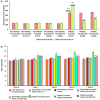Sinapic acid accelerates diabetic wound healing by promoting angiogenesis and reducing oxidative stress
- PMID: 41028763
- PMCID: PMC12484733
- DOI: 10.1038/s41598-025-03890-z
Sinapic acid accelerates diabetic wound healing by promoting angiogenesis and reducing oxidative stress
Abstract
The incidence of delayed wound healing associated with diabetes is increasing globally. Synthetic drugs for wound management often carry adverse effects, underscoring the need for safer and more effective alternatives. Sinapic acid, a phytochemical found in edible plants such as spices, citrus fruits, and berries, has drawn attention for its potential in addressing diabetic wounds. This study investigates the protective effects of sinapic acid at two pharmacological doses in mitigating delayed wound healing and oxidative stress linked to type 2 diabetes. In-vitro, the effects of sinapic acid on cell toxicity, migration, and antioxidant activity were evaluated under high-glucose conditions using L929 murine fibroblast cells and human umbilical vein endothelial cells (HUVEC). In-vivo, diabetic wounds were induced in male Sprague Dawley rats fed with high-fat diet and treated with streptozotocin. Sinapic acid was administered orally at 20 mg/kg and 40 mg/kg, and its efficacy was assessed using an excision wound model. Key markers, including hepatic, and lipid profiles, were analyzed. The findings revealed that sinapic acid significantly improved blood glucose levels and oxidative stress markers in diabetic wound rats. Enhanced angiogenesis, re-epithelialization, wound contraction, cell migration, and SIRT1 levels were observed. This is the first report demonstrating that oral sinapic acid at 20 mg/kg and 40 mg/kg mitigates oxidative stress and promotes wound healing in streptozotocin/high-fat diet (STZ/HFD)-induced diabetes, with lower doses showing greater efficacy.
Keywords: Angiogenesis; Delayed wound healing; Diabetes; Oxidative stress; Sinapic acid.
© 2025. The Author(s).
Conflict of interest statement
Declarations. Competing interests: The authors declare no competing interests.
Figures













References
-
- IDF Diabetes Atlas, 11th edn. Brussels, Belgium: International Diabetes Federation (2025).
MeSH terms
Substances
LinkOut - more resources
Full Text Sources

